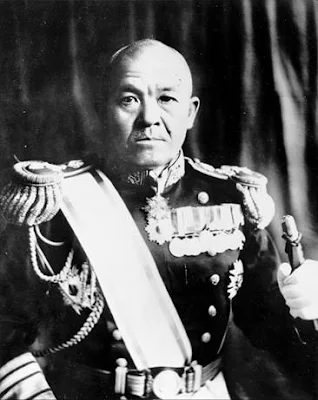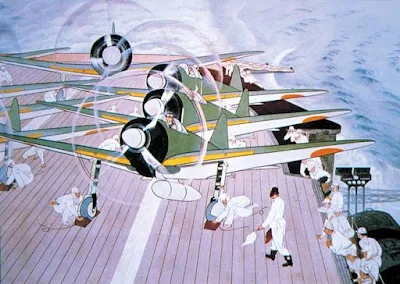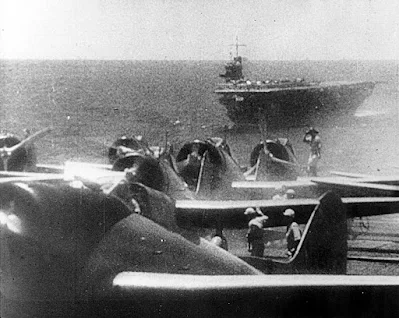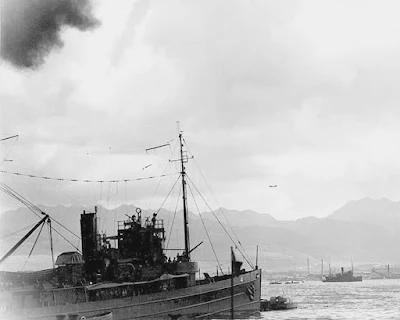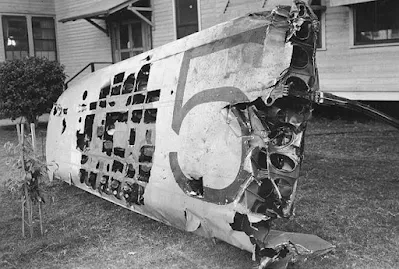It was early morning, 7 December 1941. As the sun was just
beginning to rise in Oahu, Hawaii, a fleet of Japanese naval air forces were
taking off from their respective aircraft carriers in various locations in the
Pacific Ocean. Just as many of the islanders were waking up for breakfast, it
happened. The Japanese air fleet had arrived with a vengeance. No one was
prepared for what was occurring. Pearl Harbor, the United States’ center for
military action in the Pacific Ocean, was almost completely destroyed. Anger
toward the Japanese spread quickly throughout the entire country, and this
anger led to the United States’ entry into World War II.
Events Leading Up to the Attack
Before entering World War II, Japan had many other problems
to deal with. It had begun to rely more and more for raw materials (especially
oil) from outside sources because their land was so lacking in these. Despite
these difficulties, Japan began to build a successful empire with a solid
industrial foundation and a good army and navy. The military became highly
involved in the government, and this began to get them into trouble. In the
early 1930’s, the Japanese Army had many small, isolated battles with the
Chinese in Manchuria. The Japanese Army prevailed in the series of battles, and
Manchuria became a part of the Japanese political system. In 1937, the
conflicts began again with the Chinese in the area near Beijing’s Marco Polo
Bridge. Whether or not these conflicts began inadvertently or whether they were
planned is unknown. These led to a full-scale war known as the second
Sino-Japanese War. This was one of the bloodiest wars in world history and
continued until the final defeat of Japan in 1945.
In 1939, World War II was beginning with a string of
victories by German forces. Germany’s success included defeats of Poland and
France along with a seizure of England. Many of the European nations that
Germany now controlled had control over important colonial empires such as the
East Indies and Singapore in Southeast Asia. These Southeast Asian countries
contained many of the natural resources that Japan so desperately needed. Now
that these countries were worried about matters over in Europe, Japan felt that
it should seize the opportunity to take over some of them.
At the same time in the United States, President Franklin D.
Roosevelt wanted to halt the expansion of Germany and Japan, but many others in
the government wanted to leave the situation alone. The United States began to
supply materials to the countries at war with Germany and Japan, but it wanted
to remain neutral to prevent an overseas war. Meanwhile, Germany, Italy, and
Japan formed the Axis Alliance in September of 1940. Japan was becoming
desperate for more natural resources. In July of 1941, Japan made the decision
to secure access to the abundance of the much needed resources in Southeast
Asia. It was afraid that it could not defeat the larger and stronger Western
powers. It needed to build up its armies in order to stay in the war. It also
had to worry, though, about the United States’ reaction to their plans to seize
Southeast Asia.
Japan began their seizure with southern Indochina. (They
already controlled northern Indochina.) The United States was in strict
opposition to Japan’s plans, and began their reaction with an embargo on the
shipment of oil to Japan. Oil was necessary to keep Japan’s technology and
military progressing. Without it, Japan’s industrial and military forces would
come to a stop in only a short time. Japan’s government viewed the oil embargo
as an act of war.
Throughout the next few months of 1941, the United States
tried to come to some kind of resolve with Japan to settle their differences.
Japan wanted the United States to lift the oil embargo and allow them to
attempt a of China. The United States refused to lift the embargo until
takeover Japan would back off of their aggression with China. Neither country
would budge on their demands, and war seemed to be inescapable.
The United States regarded Japan’s adamant refusal to budge
on their stance as a sign of hostility. They too realized that war was
inevitable. They responded to this potential war with Japan by adding to the
military forces stationed in the Pacific. General Douglas MacArthur and his ground
forces in the Philippines began to organize into a formidable army. The B-17
was just arriving at many air force bases throughout the country, and was a
great confidence to MacArthur upon its arrival. MacArthur became so confident
in his forces stationed in the Philippines that on 5 December 1941 he said,
“Nothing would please me better than if they would give me three months and
then attack here.”
The most powerful and most crucial part of American defense
in the Pacific Ocean was that of the U.S. Pacific Fleet. Usually, this fleet
was stationed somewhere along the west coast of the United States, and made a
training cruise to Hawaii each year. With war looming, the U.S. Pacific Fleet
was moved to the Pearl Harbor naval base in Hawaii. This was the perfect
location for the American forces in the Pacific because of its location,
halfway between the United States west coast and the Japanese military bases in
the Marshall Islands. The Pacific Fleet first arrived at Pearl Harbor naval
base on 2 April 1940, and were scheduled to return to the United States
mainland around 9 May 1940. This plan was drastically changed because of the
increasing activity of Italy in Europe and Japan’s attempt at expansion in
Southeast Asia. President Roosevelt felt that the presence of the Pacific Fleet
in Hawaii would retard any Japanese attempt at a strike on the United States.
Admiral James O. Richardson of the Pacific Fleet was in full opposition to the
long stay at Pearl Harbor. He felt that the facilities were inadequate to
maintain the ships or crews. Admiral Harold R. Stark, Chief of Naval
Operations, was the one who originally made the decision to extend the crew’s
stay in Hawaii; and, in spite of Admiral Richardson’s complaints, he maintained
that the Pacific Fleet must stay there to keep the Japanese from entering the
East Indies. Richardson felt that the Japanese would realize the military
disadvantages of being stationed at Pearl Harbor, and would be quick to act on
the situation. All of Richardson’s objections, in meetings with both the
Secretary of the Navy Frank Knox and the President, got him nothing but a
dismissal shortly thereafter.
On 12 November 1940, British torpedo bombers launched an
attack on the Taranto harbor in Italy. This sent worry into United States government
officials who were afraid that the same thing could happen to Pearl Harbor. On
22 November, Admiral Stark suggested to Richardson the idea of placing
anti-torpedo nets in Pearl Harbor. Richardson replied that they were neither
necessary nor practical. On 1 February 1941, Richardson was officially replaced
by Admiral Husband E. Kimmel. Kimmel also did not like the idea of his fleet at
Pearl Harbor; but, after seeing what had happened to Richardson, he was very
quiet about his objections. The Pacific Fleet was to be used as a defensive
measure to direct Japan’s attention away from Southeast Asia by:
Capturing the Caroline and Marshall
Islands
Disrupting Japanese trade routes,
and
Defending Guam, Hawaii, and the
United States mainland. Kimmel was supposed to prepare his fleet for war with
Japan.
Admiral Isoroku Yamamoto, commander-in-chief of Japan’s
Combined Fleet, had to be careful of his country’s position in the Pacific. If
he concentrated his forces too much in the Pacific islands, then the mainland
would be more susceptible to attack from Europe and even the United States.
Yamamoto devised a plan that involved an opening blow to the United States
Pacific Fleet at the same time as their offensive against British, American,
and Dutch forces in Southeast Asia. He planned to cripple the United States
while he quickly conquered much of Southeast Asia and gathered their natural
resources. He hoped that his attack against the Pacific Fleet would demoralize
the American forces and get them to sign a peace settlement allowing Japan to
remain as the power in the Pacific. A month after the British attack on Taranto
harbor, Yamamoto decided that if war with the United States was unavoidable he
would launch a carrier attack on Pearl Harbor. In January of 1941, Yamamoto
first began to commit to this strategy by planning out his attack and showing
it to other Japanese officials. Yamamoto developed the following eight
guidelines for the attack:
Surprise was crucial
American aircraft carriers there
should be the primary targets
U.S. aircraft there must be
destroyed to prevent aerial opposition
All Japanese aircraft carriers
available should be used
All types of bombing should be used
in the attack
A strong fighter element should be
included in the attack for air cover for the fleet
Refueling at sea would be
necessary, and
A daylight attack promised best
results, especially in the sunrise hours.
Many of Japan’s Navy General Staff were in opposition to
Yamamoto’s plan, but they continued to prepare for the attack. All of the
necessary training was given to troops, and all of the fighters and submarines
were prepared.
The Bombing Begins
There were peace talks occurring up until about 27 November
1941. At that time, negotiations had come to a halt. The United States put its
troops on alert. On 6 December 1941, President Roosevelt made an appeal for
peace to the Emperor of Japan. Not until late that day did the U.S. decode
thirteen parts of a fourteen part message that presented the possibility of a
Japanese attack. Approximately 9 a.m. (Washington time) on 7 December 1941, the
last part of the fourteen part message was decoded stating a severance of ties
with the United States. An hour later, a message from Japan was decoded as
instructing the Japanese embassy to deliver the fourteen part message at 1 p.m.
(Washington time). The U.S., upon receiving this message sent a commercial
telegraph to Pearl Harbor because radio communication had been down.
At 6 a.m. (Hawaiian time) on 7 December 1941, the first
Japanese attack fleet of 183 planes took off from aircraft carriers 230 miles
north of Oahu. At 7:02 a.m., two Army operators at a radar station on Oahu’s
north shore picked up Japanese fighters approaching on radar. They contacted a
junior officer who disregarded their sighting, thinking that it was B-17
bombers from the United States west coast. The first Japanese bomb was dropped
at 7:55 a.m. on Wheeler Field, eight miles from Pearl Harbor. The crews at
Pearl Harbor were on the decks of their ships for morning colors and the singing
of The Star Spangled Banner. Even though the band was interrupted in their song
by Japanese planes gunfire, the crews did not move until the last note was
sung. The telegraph from Washington had been too late. It arrived at
headquarters in Oahu around noon (Hawaiian time), four long hours after the
first bombs were dropped.
Aftermath of the Bombing
Of the approximately one hundred U.S. Navy ships present in
the harbor that day, eight battleships were damaged with five sunk. Eleven
smaller ships including cruisers and destroyers were also badly damaged. Among
those killed were 2,335 servicemen and 68 civilians. The wounded included 1,178
people. The U.S.S. Arizona was dealt the worst blow of the attack. A 1,760
pound bomb struck it, and the ammunition on board exploded killing 1,177
servicemen. Today, there is a memorial spanning the sunken remains of the
Arizona dedicated to the memory of all those lost in the bombing.
News of the attack was a shock to the entire nation. The bombing
rallied the United States behind the President in declaring war on Japan. On 11
December, Germany and Italy declared war on the U.S., bringing about a global
conflict. The United States would later drop two atomic bombs on the Japanese
cities of Hiroshima and Nagasaki, bringing Japan to complete surrender on 14
August 1945.




